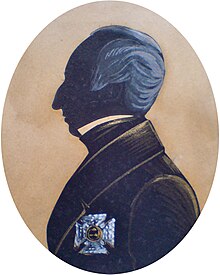John Cameron (British Army officer, born 1773)
Sir John Cameron | |
|---|---|
 Lieutenant-General Sir John Cameron, KCB | |
| Born | 3 Jan 1773 Culchenna, Inverness, Scotland |
| Died | 23 Nov 1844 (aged 71) Guernsey, Channel Islands |
| Allegiance | |
| Service/ | |
| Years of service | 1787-1844 |
| Rank | Lieutenant-General |
| Commands held | 43rd Regiment of Foot Western District |
| Battles/wars | Invasion of Guadeloupe (1794) Peninsular War |
| Awards | KCB Knight of the Tower and Sword (Portugal) |
| Relations | Captain Ewen Cameron, 43rd Foot, killed at Battle of the Côa, 24 July 1810 (brother) General Sir Duncan Alexander Cameron GCB (1808-1888) (son) Maj.-Gen. John Cameron RE, CB, FRS (1817-1878), Director-General of the Ordnance Survey (son) |
Lieutenant-General Sir John Cameron, KCB (3 January 1773 – 23 November 1844), of Culchenna, Inverness, Scotland, was a British Army officer and commander during the French Revolutionary Wars and the Napoleonic Wars.[1]
Military career[edit]
Cameron was commissioned as an ensign on 25 September 1787.[2] He served in the West Indies with the 43rd Regiment of Foot, under Sir Charles Grey, and was present at the siege of Fort Bourbon, the capture of Martinique, St. Lucia and Guadeloupe, and at the assault made by the enemy of Fleur d'épée; he next served under Brigadier-General C. Graham at Berville Camp in Guadeloupe; and commanded the Regiment engaged in the action of the 30 September 1794, and in different attacks made by the enemy until 4 October 1794, when he was severely wounded and taken prisoner, in which situation he remained two years (on a prison hull at Pointe-à-Pitre).[2]
He received the Gold Medal for his services at the Battle of Roliça, Battle of Vimeiro, Battle of Corunna, Battle of Bussaco, Battle of Salamanca, Battle of Vitoria, Siege of San Sebastián and Battle of Nive.[3] "In consideration of his eminent services, and we can honestly assert that there was not a better soldier in any army; he was nominated a Knight Commander of the Military Order of the Bath, by his Sovereign. The Portuguese Government conferred the Order of the Tower and the Sword on Sir John for the able services he rendered to that nation."[2]
Promoted to major-general on 19 July 1821,[4] he was appointed a Knight Commander of the Order of the Bath in April 1822.[5] He became Lieutenant-Governor of Plymouth and General Officer Commanding Western District on 25 September 1823.[6] He was also appointed Colonel of the 93rd Regiment of Foot on 23 July 1832[7] and Colonel of the 9th Regiment of Foot on 31 May 1833.[8]
He was promoted to lieutenant-general on 10 July 1837[9] and died at Guernsey on 23 November 1844.[2]
Family[edit]
Camerons of Culchenna (also spelled Cuilcheanna) are descended from John, second son of Allan of the Forays, who was the XII. Chief of the Clan Cameron.[10] Alternatively, Cameron's ancestry in 1848 was described as "... second son of Culchenna, and nephew of Cameron of Caltort, Inverness-shire, whose ancestor was a younger son of Lochiel, chief of the clan."[11]
Cameron married Amelia Brock, daughter of Henry Brock, Esq., and niece of Admiral James Saumarez, 1st Baron de Saumarez on 10 October 1803, while stationed in Guernsey, Channel Islands. Amelia was a first cousin of Major-General Sir Isaac Brock. The children of Lieut.-Gen. Sir John Cameron and Amelia Brock are:
- Amelia Susannah Brock Cameron (1805–1883)
- Anne Alicia Cameron (7 Sep 1805 - 13 February 1852), who married the Rev. Henry Curtis Cherry, rector at St Mary's Parish Church in Burghfield, Berkshire and died after giving birth to her 15th issue.
- General Sir Duncan Alexander Cameron, GCB, (20 May 1808 - 8 June 1888) who fought in the Crimean War(1853 to 1856), commanded troops during part (1861 to 1865) of the New Zealand Wars and was Governor of Royal Military College, Sandhurst, from 1868 to 1875.
- Marion Mount Cameron (29 June 1813 - 8 January 1859), who married the physician Frederick Le Mesurier and had issue.
- Lieut.-General John Cameron, RE, CB, FRS (31 March 1817 - 30 June 1878), who was Director-General of the Ordnance Survey from 1875 to 1878.
References[edit]
- ^ . Dictionary of National Biography. London: Smith, Elder & Co. 1885–1900.
- ^ a b c d Levinge, Sir Richard George Augustus (1868). "Historical records of the Forty-third Regiment, Monmouthshire Light Infantry: with a roll of the officers and their services from the period of embodiment to the close of 1867". Clowes. p. 301.
- ^ Major Augustus F. Mockler-Ferryman F.R.G.S., F.Z.S. Annals of Sandhurst: a chronicle of the Royal Military College from its foundation to the present day, with a sketch of the history of the Staff College (London: William Heinemann, 1900), page 79.
- ^ "No. 17727". The London Gazette. 20 July 1821. p. 1510.
- ^ "No. 17810". The London Gazette. 20 April 1822. p. 653.
- ^ "No. 17985". The London Gazette. 20 December 1823. p. 2120.
- ^ "No. 18959". The London Gazette. 24 July 1832. p. 1703.
- ^ "No. 19056". The London Gazette. 7 June 1833. p. 1110.
- ^ "No. 19456". The London Gazette. 10 January 1837. p. 64.
- ^ "Family Roots in the Cameron Clan". Retrieved 13 December 2015.
- ^ Cannon, Richard. 1848. Historical record of the Ninth, or the East Norfolk Regiment of Foot: containing an account of the formation of the regiment in 1685, and of its subsequent services to 1847. p. 127-129. Retrieved 17 October 2018 from archive.org.
- 1773 births
- 1844 deaths
- Military personnel from Inverness
- People educated at Eton College
- People of the Peninsular War
- Knights Commander of the Order of the Bath
- Commandants of Sandhurst
- Scottish generals
- British Army lieutenant generals
- 43rd Regiment of Foot officers
- 93rd Regiment of Foot officers
- Royal Norfolk Regiment officers
